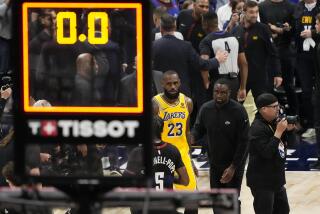On the Media: ESPN can’t just bigfoot its way into local markets
Joe Davidson has been slinging copy for the Sacramento Bee for more than 20 years and, though he loves pro and college games, the sportswriter’s real passion is high school sports.
FOR THE RECORD:
ESPN.com: The On the Media column in Wednesday’s Calendar section about ESPN.com and other online sports sites should have noted that the Los Angeles Times has a business relationship with BleacherReport.com, which provides co-branded pages to The Times in a revenue-sharing arrangement. The column also gave an audience figure for another site, SBNation.com, of more than 1.3 million unique visitors a month. That figure, from comScore.com, refers to one of the site’s principal pages, but SBNation operates 270 sites, which drew a total of about 4.7 million in the most recent month on record, according to the ratings service. —
Davidson has become enough of a fixture that coaches and fans in Folsom must have been surprised Friday when a television producer shouted at the veteran writer that he didn’t belong in the press box for the big Grant-Folsom high school football game.
When Davidson insisted that he indeed did have a seat reserved in the press box, the TV woman snapped: “I’m ESPN!”
Perhaps ESPN will one day dominate metro and community sports news the way it does the national sports universe. But it won’t get there simply by showing up and announcing its arrival.
The recent dispute involved a high school football telecast. But the all-sports network may face similar challenges as it plunges into local sports coverage online. It can’t just show up — as it has in Los Angeles and four other cities in the last year — and expect to earn a permanent and meaningful foothold in these local markets.
The ESPN brand carries a lot of weight and has been a powerful revenue engine for its parent Walt Disney Co. But it remains far from certain whether the expansion into metropolitan markets around America, announced about a year ago, will snatch huge chunks of the audience from established local outlets.
According to one insider and competitors who follow ESPN.com closely, the sports giant has slowed plans to expand into other cities and become more cautious about the prospects of significant growth from local operations. When I asked an ESPN executive about those contentions Tuesday, though, he said the outlet continues to plan to add local operations.
The self-proclaimed “Worldwide Leader in Sports” is chasing the same opportunities as many other Internet operators entering the local journalism fray: potentially large audiences and lucrative advertising that seems relatively untapped.
The trick has been to provide enough new information to attract an audience but to do so on the relative cheap, since Internet advertising rates are too low to support large teams of reporters, editors and photographers.
ESPN declined to discuss how many staffers it has hired in Los Angeles, Boston, New York, Dallas and Chicago. But it has writers on major pro and college teams and also beefed up staffing to cover high school sports.
Among those featured on the ESPN Los Angeles site are Dodger Thoughts blogger Jon Weisman, whose work previously appeared on the Los Angeles Times website, and the Kamenetzky brothers, Brian and Andy, whose blog on the Lakers also won them a large following on latimes.com.
The Internet traffic measurement company comScore put ESPN Los Angeles’ at nearly 2.7 million unique visitors a month for July, its strongest month since its founding this year. The audience has generally been trending upward in the other four cities too.
Yet one insider, who asked not to be named because he was not authorized to speak for ESPN, said the network expected more. And while the local reporters have undoubtedly expanded the range of coverage on local sports (the Kamenetzky brothers, for instance, have recently been taking an off-season look at what to expect from the Lakers next season), the ESPN locals haven’t landed the kind of blockbuster scoops, exclusive interviews or consistently stylish features to win a high profile.
The name-brand sports authorities in big cities still tend to lurk at newspapers or radio and television stations.
As a business proposition, it remains to be seen whether the ESPN locals will build a big enough audience or bring in enough money to make all the effort worth the trouble.
One Internet executive who has watched companies try to crack the local market in news, sports and other niches said there have been few clear winners, despite many attempts over more than a decade.
“It’s too soon to discount anyone,” said Alan Citron, president of Buzz Media, which owns a group of entertainment and celebrity sites, and who was once a journalist at the Los Angeles Times. “We can’t say yet what does work and what doesn’t work in these local operations.”
It’s not like sports fans lack choices online. Newspapers, radio and TV have been supplemented in recent years by websites sponsored by professional leagues and teams. Independent bloggers continue to expand, with many now coming under the auspices of Internet companies.
One of those is SBNation.com. The Washington-based network of 270 team-centric and sport-specific and geographically focused websites (each operating under its own Web address) pays part-timers to produce most of its content. Many of the writers are lawyers, looking for an outlet for their writing and argumentative skills, said SBNation chief executive Jim Bankoff.
A competitor from another website admired the way SBNation’s (the name is derived from its earlier title, Sports Blog Nation) technical platform makes it easy to create and post new content. He also suggested that quality varies markedly from one SBNation site to the next.
The series of websites, inspired originally by an Oakland A’s fan/blogger who was disappointed in mainstream media coverage of his team, now has more than 1.3 million unique visitors a month, according to comScore.
Another competitor, BleacherReport.com, relies mostly on amateur reporters to cover a variety of teams and sports. The site has been growing steadily, to nearly 6 million unique visitors in July, though it’s hard to say how much of the audience comes for sports and how much is lured in by cheesecake photo galleries, many of cheerleaders, that fill the margins of the site.
BleacherReport aggressively pursues readers to subscribe to e-mail reports on their favorite teams. A persistent pop-up ad eventually lured me to agree to get regular updates on my college alma mater’s football team.
That brought another important lesson: The reports about the California Golden Bears might not be consistently great, but good enough will sometimes do. The BleacherReport e-mails update me on recruiting, injuries and coaches’ briefings. The information sometimes comes from one of the site’s writers and sometimes from links to newspapers in the Bay Area.
The experience verified a truism of Internet journalism — that scoops and brilliant writing can be nice but that user convenience often wins the day.
In that vein, ESPN has introduced iPhone apps for each of its local sites, to provide easier access to its information and to give customers easy access to its radio programs. A mantra for the company is “live, local and social.”
Davidson told me Tuesday that he has no grudge against the sports network. He has worked alongside many of its reporters and producers for years and gotten along with almost all. The one who got out of line over the weekend has apologized, as has an ESPN executive.
The sports networks’ bigger battles loom on the Internet. But the lesson learned could be the same: When the big boys go local, it’s best to proceed with humility.
james.rainey@latimes.com
Twitter: latimesrainey
More to Read
Get our high school sports newsletter
Prep Rally is devoted to the SoCal high school sports experience, bringing you scores, stories and a behind-the-scenes look at what makes prep sports so popular.
You may occasionally receive promotional content from the Los Angeles Times.







